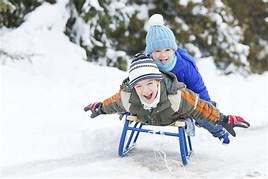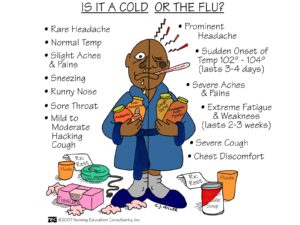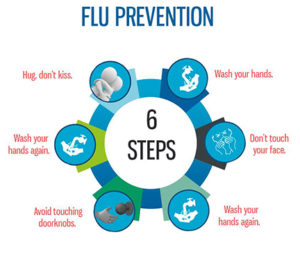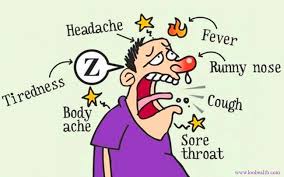
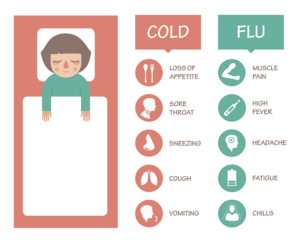
“Flu” is an illness caused by a number of different influenza viruses that usually bear the name of the locality where they originated. Most college-age students are susceptible to the virus because of their proximity with others in classrooms, in dormitories, in the dining halls and elsewhere on campus. The influenza virus is very contagious and spreads easily in crowded areas by droplets of respiratory fluid that become airborne or by direct contact with recently contaminated surfaces.
People infected with an influenza or cold virus become contagious 24 hours after the virus enters the body (often before symptoms appear). Adults remain infectious (can spread the virus to others) for about 6 days, and children remain infectious for up to 10 days. Factors that may increase the risk of catching a cold are fatigue, emotional stress, smoking, mid-phase of the menstrual cycle, and nasal allergies. Factors that do not increase the risk of catching a cold include cold body temperature (Example being out in the cold or enlarged tonsils). General health status and eating habits do in that they have impact on your immunity and “fight or flight” in fighting off infection as opposed to getting sick due to a healthy body overall.
Watch for flu symptoms and in comparison here with the cold symptoms when trying to decipher what you have before going to the doctor. Signs and symptoms (S/S):
Flu s/s=High Fever lasting 3 to 4 days, prominent headache, general aches and pains which are often and severe, fatigue & weakness that lasts up to 2-3 wks., extreme exhaustion-early & prominent chest discomfort, cough-common & severe at times. *Note weakness and tiredness can last up to a few weeks with the Flu.
Cold S/S-Fever-rare, headache-rare, slight aches, mild fatigue if even present, extreme exhaustion (never occurs), Chest discomfort-mild if present, cough-moderate and hacking cough with sore throat sometimes present.
Common symptom: Stuffy nose is present, a common symptom for children is diarrhea and vomiting.
Regarding cold symptoms also be aware for these specifics, which include:
-Sore throat-usually is going away in about a day or three; nasal symptoms include runny nose and congestion to follow, along with a cough by the fourth or fifth day. Also, fever is uncommon in adults but a slight fever is possible. For children fever they can have with their cold. * -With the symptoms above you can also have the nose that teems with watery nasal secretions for the first few days later these become thicker and darker. Dark mucus is natural and does not mean you have developed a bacterial infection, such as a sinus infection.
**Know several hundred different viruses may cause your cold symptoms. A virus cannot be treated with an antibiotic since antibiotics can only fight off bacterial infections.**
Now let’s review what we know now, which is the common cold and the types of flu (Types A,B, and C), we know their symptoms (the cold versus the flu), we even know The Flu statistics of how many are affected yearly with what complications can arise, based on Part 1 and part of Part 2. The most important part of this article is letting my readers know or be aware of factors in prevention.
Let’s prepare ourselves in knowing factors for prevention of these 2 BUGS THE COLD and THE FLU (particularly) with knowing what to do when you or someone in the home has it.
The biggest factor in prevention of the COMMON COLD or THE FLU is living out your life utilizing great healthy habits and that would be washing your hands with soap and water often, especially:
- Before, during, and after preparing food
- Before eating
- After using the bathroom
- After handling animals or animal waste
- When their hands are dirty
- When someone in your home is sick.
- FOR AVOIDANCE IN GETTING THE FLU OBTAIN YOUR VACCINE YEARLY!
- Keep your face off-limits; This means the following:
The flu virus enters through the eyes, nose, and mouth, so those with the flu or a simple cold should never touch their faces unless they’ve just washed their hands.
Avoid sharing food, drinks, and utensils. Do not share drinking glasses-and to break off portions of food and to pour off beverages before consuming them.
Keep tissues handy. The flu spreads when infected people cough or sneeze. So adults use them and encourage your kids to cough and sneeze into a tissue or their upper arm if tissues aren’t available. (Coughing into a bare hand can also spread germs if kids touch something before they can wash.)
Ask your doctor about antiviral medications. Although not approved for use in children under 1, these drugs can be used in older children & adults to prevent influenza or even can treat the flu in the first 2 days of onset.
OTHER FACTORS IN PREVENTION:
- Live a healthy lifestyle. MOST IMPORTANT!!! A healthy lifestyle may help prevent them from getting sick in the first place.
- Use those wipes! Flu germs can live for several hours on surfaces such as countertops and doorknobs. Wipe down contaminated objects with soap and water.
- Let your kids, including adults stay home when they’re sick. They’ll feel better sooner and won’t pass their illness on to their classmates or for an adult passing it on to colleagues at work especially the first few days when contagious so don’t go into work those few days.
- For a child and an adult keeping the same routine schedule. For a child – keeping the same schedule for play time, bath, pajamas, bottle, story, then bed. Keeping a routine helps, that is one that is healthy of course.
- Make sure you or your sick child who is sick gets enough sleep. Too little sleep can cause the feeling of run-down and lower the immunity. Yet a National Sleep Foundation poll found that most children need 1 to 3 more hours of sleep than they’re getting every night usually. How much should they be getting? Experts recommend 11 to 13 hours a night for preschoolers and kindergartners and 10 to 11 hours for school-aged children. Adults 8 hours of sleep a day if not more when sick with a cold or the flu. How to make sure this can be accomplished: Establish an earlier-bedtime routine, this just takes discipline by the parent or yourself if an adult that is sick.
- Keep your distance. Stay clear of people who are sick-or feel sick.
- What to do when you have the cold or, worse, the flu: Take care of yourself with rest, eating and drinking properly, going to sleep earlier, going to your doctor for treatment and changing your life style to a more healthier one with always practicing good health habits in your daily living=PREVENTION if your not already or just improving on those good habits your doing now.
- Recommended is to check with your MD on any changes with diet or exercise or daily habits especially if diagnosed already with disease or illness for your safety.****
REFERENCES FOR PART 1,2, AND 3 ON THE COLD AND THE FLU ARE:
1-Wikipedia “the free encyclopedia” 2013 website under the topic Influenza.
2-Kimberly Clark Professional website under the influenza.
3-Web MD under “COLD, FLU, COUGH CENTER” “Flu or cold symptoms?” Reviewed by Laura J. Martin MD November 01, 2011
4-2013 Novartis Consumer Health Inc. Triaminic “Fend off the Flu”
5-Scientific American “Why do we get the flu most often in the winter? Are viruses virulent in cold weather? December 15, 1997


